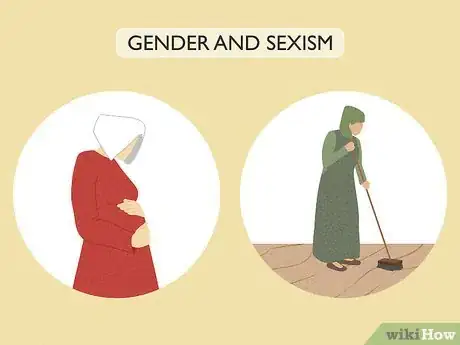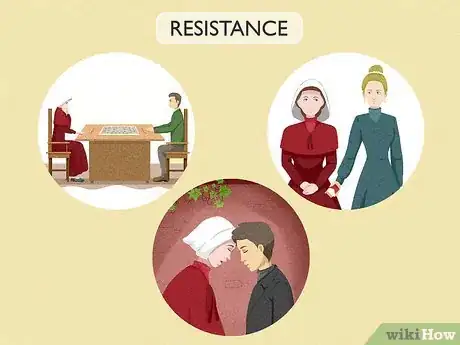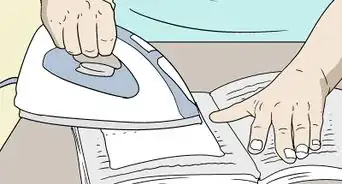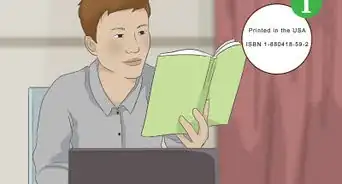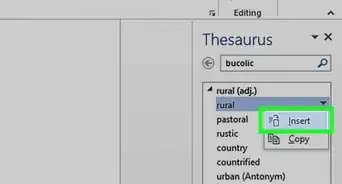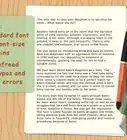This article was co-authored by wikiHow staff writer, Sophia Latorre. Sophia Latorre is a Content Manager on the wikiHow team. Before joining wikiHow, Sophia worked as a technical editor and was published in six International Energy Agency (IEA) Wind Annual Reports. Now, she writes, edits, and reviews articles for the wikiHow Content Team, working to make the content as helpful as possible for readers worldwide. Sophia holds a BA in English from Colorado State University.
This article has been viewed 9,977 times.
Learn more...
The Handmaid’s Tale, written by Margaret Atwood, is a speculative fiction novel published in 1986. This classic work is a worldwide bestseller that has since been transformed into a hit Hulu series! If you need some help unpacking this novel, read on for tips on understanding everything from the setting to the plot to the themes.
Steps
Analyzing the Setting, Society, and Characters
-
1Scrutinize the Republic of Gilead. While this novel is set in Massachusetts in the U.S., it’s a very different world than present-day Massachusetts. Gilead is founded on a skewed interpretation of the story of Jacob, his wives, and their handmaids from the Book of Genesis in the Bible. In the novel, fertile women are coerced into serving as Handmaids for upper-class families that can’t conceive children of their own.
- Compare and contrast Gilead to modern-day America. How are the governments and social structures similar? How are they different?
-
2Examine the roles that various characters play in the society of Gilead. The citizens of Gilead are broken up into different categories. The Aunts re-educate Handmaids so they become subservient women who willingly bear children for infertile high-status couples. The men the Handmaids work for are called Commanders and their Wives’ only duty is to raise the children the Handmaids bear. Male Guardians enforce the laws on a day-to-day basis.
- Influential families have Marthas, or servants, who take care of the household tasks.
- Angels of the Apocalypse serve in the war and Daughters of Wives are married off to them.
- Eyes are secret police with near-absolute authority.
- “Unwomen” are women who are infertile, refuse to become Handmaids, or have broken the rules and are exiled to the Colonies.
Advertisement -
3Gather details about the protagonist. Atwood never reveals the protagonist’s real name, who is referred to as Offred—the name given to her by the Republic of Gilead that symbolizes her “ownership” by Fred ("Of" + "Fred"), whom she is a handmaid for. Pay attention to how Offred views herself, those around her, and the society she is a part of to get clues about her character.
- For instance, do you think Offred approves of the Republic of Gilead?
- Is she a willing Handmaid?
- What are her relationships like with the people around her?
-
4Take note of other characters Offred mentions and interacts with. Some of the main characters in this novel include Lydia (an Aunt that re-educated Offred), The Commander and Serena Joy (whom Offred is a Handmaid for), Nick (a guardian whom Offred develops a relationship with), Moira (Offred’s friend and fellow Handmaid), Ofglen (Offred’s shopping partner), and Luke (Offred’s husband).
- Minor characters include Janine, Rita, Cora, Offred’s mother, and Offred’s daughter.
Understanding the Plot and Form
-
1Examine how the novel is broken up. The Handmaid’s Tale is divided into 46 chapters spread across 16 Parts, plus an Introduction and Historical Notes section. Take note of the names of the sections and how they correspond to the content in those pages.
- Why do you think some chapters are short while others are long?
- Why do you think some section titles are repeated? What does this signify?
-
2Follow along as the narrator switches between past and present. The plot can get a bit confusing as the narrator goes back and forth between her life before Gilead, her time at the Red Center, and her experience as a Handmaid. Do your best to notice these shifts, as they aren’t always clearly marked, and examine what they say about Offred’s character and how it changes over time.
- In the parts about Offred’s past, examine her relationships with her mother, husband, daughter, and friends.
- Consider how Offred’s experiences at The Red Center prepare her for life as a Handmaid. Think about how the doctrines of Gilead are instilled in the women.
- Examine Offred’s life in the Commander’s home and how her relationships with Serena Joy, the Commander himself, the Marthas, and Nick evolve.
-
3Pay attention to the Historical Notes at the end of the novel. The very last chapter actually has a significant impact on The Handmaid’s Tale, so don’t skip it! It’s a (fictitious) transcription of a symposium held on the Gilead regime decades after it collapsed. The speaker explains that Offred’s story was recorded on a collection of cassette tapes and discovered in Maine. The speaker speculates about the authenticity of the tapes and the true identity of Offred, Nick, Fred, and Serena Joy.
- How does this section affect your perception of Gilead, Offred, and the novel as a whole?
-
4Look up any words you don’t know. If you come across any unfamiliar terms as you’re reading, find the definitions in a dictionary, either in print or online. This will help you more fully understand what Atwood is saying and ensure you don’t miss context clues. Here are a few definitions you can refer to as you read:
- Blasphemy (n): radically against accepted religious beliefs, sacrilege
- Collusion (n): a conspiracy, usually illegal or secret
- Gallantry (n): politeness especially towards women
- Insatiable (adj): impossible to satisfy
- Palimpsest (n): something that has been repurposed but still has traces of its original form
- Sardonic (adj): mocking, sarcastic
- Volition (n): the use of one’s will
-
5Compare the novel to the television series. A film adaptation of The Handmaid's Tale is available on Hulu. While the show isn't an exact transcription of the book, it does offer a window into the world of Gilead. As you watch, think about how the series differs from the novel and why the changes were made. For instance, why is Offred's real name revealed in the show but not in the novel? How does this impact the audience's experience and connection to the protagonist?
- If you don't have a Hulu subscription but want to watch the show, try the 30-day free trial.
-
6Read the sequel to the novel if you want to know more about Gilead. Atwood published a sequel to The Handmaid's Tale in 2019 (33 years after the debut of the first novel). It's called The Testaments and takes place 15 years after the events in The Handmaid's Tale. This sequel is narrated by three women—two new characters along with Aunt Lydia. If you're intrigued by Gilead and are curious about what happens to this totalitarian regime, pick up the sequel.
Examining Themes, Motifs, and Symbols
-
1Consider how totalitarianism and theocracy shape the Republic of Gilead. Force and fear are used to control the citizens of Gilead. People who are deemed morally and religiously superior are given the most control and freedom, while a secret police force, called the Eyes, arrest, abuse, torture, and execute people who don’t follow the rules.
- How does the Wall represent Gilead’s totalitarian ideals?
-
2Think about the roles that gender, sexism, fertility, and reproduction play in this society. The Handmaids are the cornerstone of Gilead, as they symbolize procreation and bear children for high-status families. At the same time, all women, from Handmaids to Wives, have very little agency and are expected to be subservient.
- Why is fertility so important in Gilead?
- How does gender dictate one’s role in society?
- Find a few examples of sexist behavior in the novel.
-
3Factor in the role of language and storytelling in the novel. Offred continually refers to the “story” that she’s telling and occasionally speaks directly to the reader. Even the title of the novel suggests that this is simply a story. In addition, language is used to control the citizens of Gilead. Women are not allowed to read or write, and the more unpleasant aspects of this society are renamed to disguise them.
- For instance, the sexual encounters between Commanders and Handmaids are referred to as “The Ceremony.”
-
4Identify what the colors each character wears symbolize. The colors of the clothing each person wears are determined by their rank or role in Gilead. The Handmaids wear red to represent their fertility as well as their adultery. Contrastingly, the Wives wear blue, while their daughters wear white. Commanders wear black, as do widows, while Guardians of the Faith dress in green.
- Additionally, Marthas dress in dull green, and the so-called “Econowives” wear striped clothing.
-
5Contemplate how resistance plays a part in the novel. The citizens are encouraged to spy on each other and report anyone who bends or breaks the rules. While people in lower ranks, like Handmaids, usually show the most outright demonstrations of resistance, even the Commanders and their Wives fight back against the strict regime.
- List at least one way that a Handmaid, Commander, Wife, and Guardian each break the rules.
References
- wikiHow Study Guide: The Handmaid’s Tale - Original source, shared with permission.











